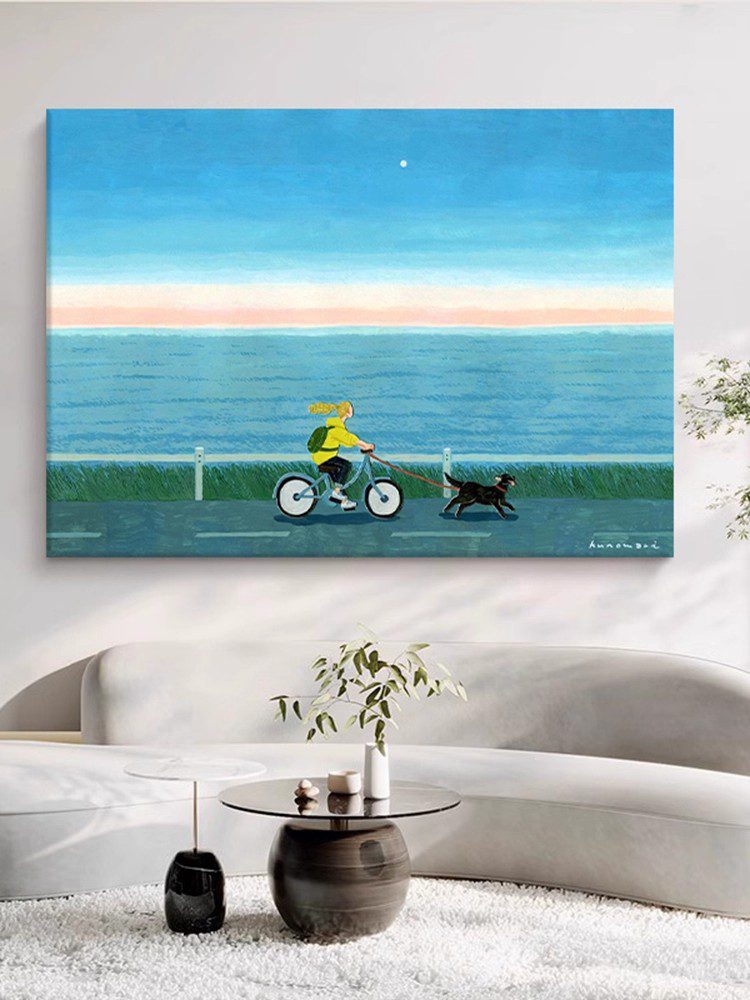The Role of Brushwork in Hand-Painted Oil Art Appreciation: Unveiling Technique, Emotion, and Artistic Identity
Brushwork is the heartbeat of hand-painted oil art, a visible record of the artist’s hand, intent, and creative process. Unlike digital or printed reproductions, oil paintings preserve the physicality of each stroke—its direction, thickness, and texture—which directly influences how viewers perceive movement, emotion, and realism. From delicate blends to bold, expressive marks, brushwork serves as a bridge between the artist’s vision and the viewer’s interpretation. Below, explore how brushwork shapes the appreciation of oil art through its technical, emotional, and stylistic dimensions.
1. Conveying Movement and Energy: Dynamic Strokes vs. Controlled Precision
Brushwork is a primary tool for suggesting motion or stillness in a painting. Loose, gestural strokes—often seen in Impressionist or Expressionist works—create a sense of spontaneity and energy. For example, short, curved brushstrokes might mimic the flicker of leaves in a breeze, while long, sweeping marks could evoke the flow of water or the grace of a dancer’s limb. In contrast, meticulous, uniform strokes (common in Realism or Classical art) convey stability and control, as in the smooth blending of skin tones or the precise rendering of architectural details. Observe how the artist varies stroke length and direction: Does the brushwork follow the natural contours of the subject, or does it disrupt them to create tension? This interplay between movement and stillness guides the viewer’s eye and emotional response.
2. Building Texture and Depth: From Flat Surfaces to Tactile Illusions
Oil paint’s versatility allows artists to manipulate texture through brushwork, adding dimensionality to a two-dimensional canvas. Impasto techniques—where paint is applied thickly with a palette knife or stiff brush—create raised, sculptural surfaces that catch light and cast shadows. This is often used to emphasize key elements, such as the rough bark of a tree, the glint of sunlight on water, or the intensity of a facial expression. Conversely, thin, glazed layers of paint produce translucent effects, ideal for subtle transitions in color or atmosphere, like the soft glow of a sunset or the misty distance in a landscape. Examine the painting’s surface: Can you feel the implied texture through visual cues? How does the artist use thick and thin strokes to create contrast between foreground and background, or between solid objects and ephemeral elements like smoke or hair?
3. Expressing Emotion and Personality: The Artist’s Unspoken Voice
Brushwork is a deeply personal aspect of oil painting, often reflecting the artist’s mood, temperament, or philosophical approach. Aggressive, jagged strokes might convey anger or chaos, while gentle, circular marks suggest calmness or introspection. For instance, Vincent van Gogh’s swirling, rhythmic brushstrokes in Starry Night evoke both the turbulence of his mental state and the dynamic energy of the night sky. Similarly, the fragmented, angular strokes in Cubist works challenge traditional perception, reflecting the artists’ intellectual exploration of form and space. Notice recurring patterns or inconsistencies in the brushwork: Does the artist maintain a consistent style throughout, or does it shift to mirror changes in the subject’s emotional tone? This emotional layer transforms technical skill into a visceral, human connection.
4. Defining Style and Period: Brushwork as a Historical and Cultural Marker
Brushwork often serves as a signature of artistic movements or individual styles. The Renaissance prioritized smooth, invisible brushstrokes to achieve lifelike realism, while Baroque artists embraced dramatic, visible marks to heighten emotional intensity. Impressionists rejected blended strokes altogether, opting for short, broken dabs of color to capture fleeting moments of light. Modern and contemporary artists frequently subvert traditional techniques, using unconventional tools (like fingers or sponges) or experimental strokes to challenge norms. Researching the historical context of a painting can deepen appreciation: How does the brushwork align with or deviate from the conventions of its time? Does it reference earlier styles or pave new creative paths? These questions reveal brushwork’s role in shaping art history.
5. Guiding Visual Hierarchy: Directing Attention Through Stroke Variation
Artists use brushwork strategically to control where viewers look first and how their gaze moves across the canvas. Bold, textured strokes in the focal point (e.g., a figure’s face or a vibrant flower) draw immediate attention, while softer, more uniform strokes in secondary areas recede into the background. This hierarchy creates balance and narrative flow. For example, a portrait might feature detailed, textured brushwork on the subject’s face and hands, while the background remains loosely painted to avoid distraction. Analyze the painting’s composition: Are certain elements emphasized through thicker, more dynamic strokes? How does the artist use brushwork to unify disparate elements or create contrast between competing focal points?
Brushwork is far more than a technical aspect of oil painting—it is a language of its own, communicating movement, emotion, texture, and intent. By examining its role in conveying energy, building depth, expressing personality, defining style, and guiding hierarchy, viewers gain a richer, more nuanced understanding of hand-painted oil art. Each stroke, whether deliberate or spontaneous, tells a story, inviting viewers to engage not just with the subject, but with the artist’s process and vision.
